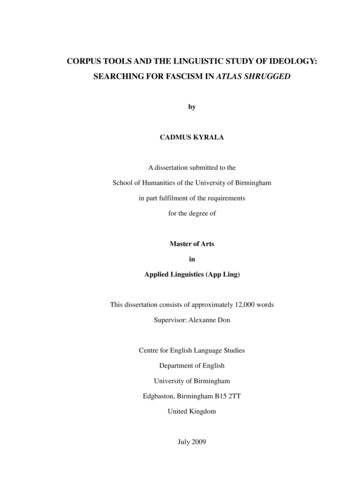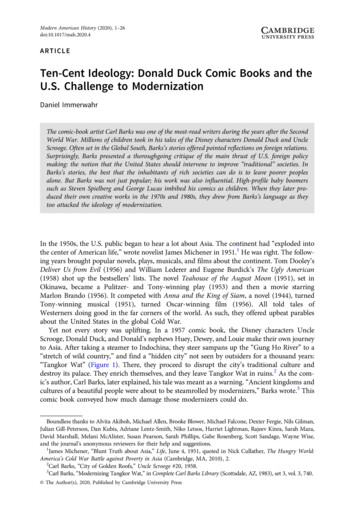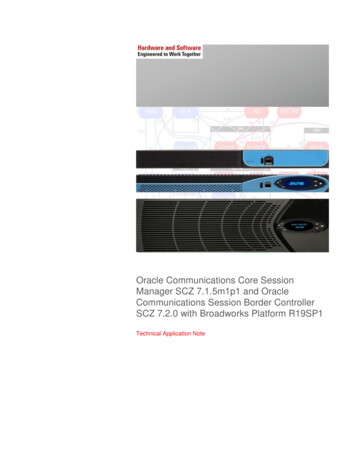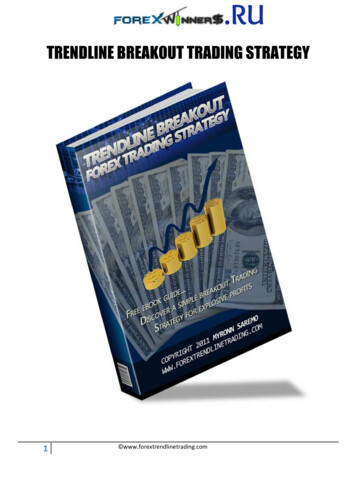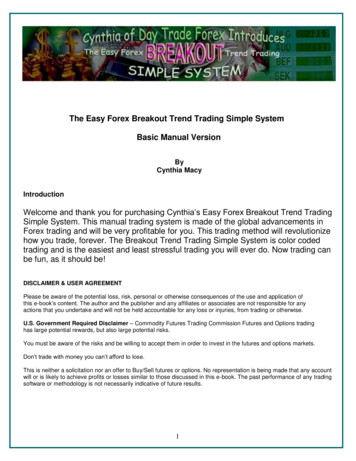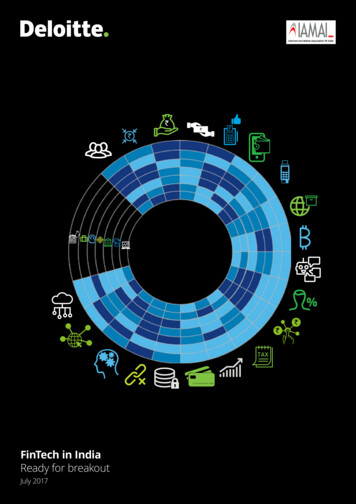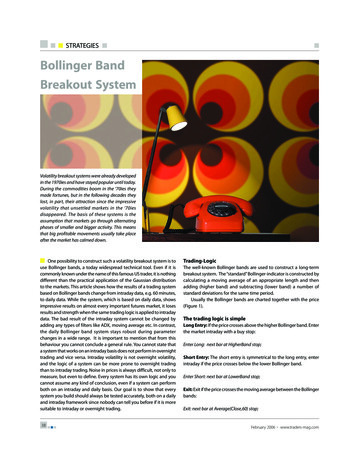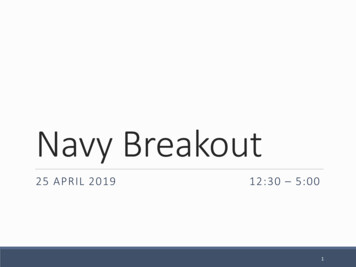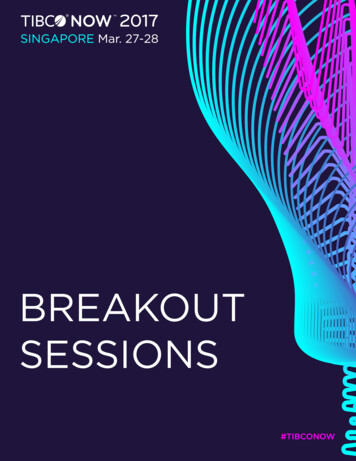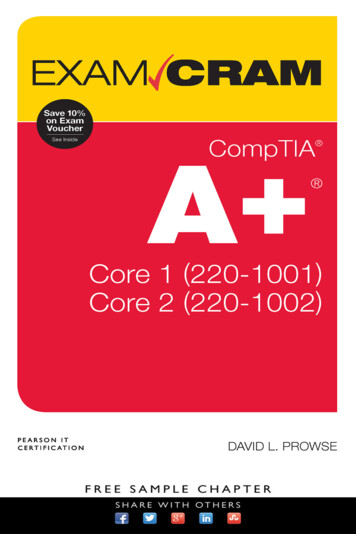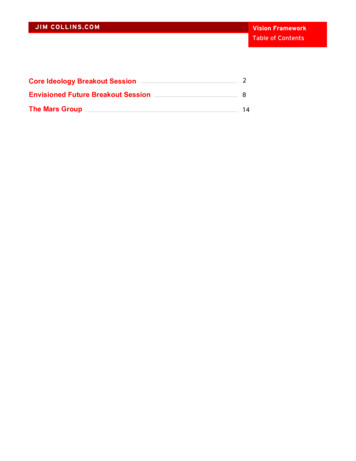
Transcription
JI M COLL INS.CO MVision FrameworkEnvisioned FutureTableof ContentsBreakoutSessionCore Ideology Breakout Session2Envisioned Future Breakout Session8The Mars Group14
JI M COLL INS.CO MVision FrameworkCore IdeologyBreakout SessionFor the most successful application of the Collins/Porras Vision Framework it should be used in conjunction withBuilt to Last: Successful Habits of Visionary Companies (chapters 3, 4, 5, and 11) and the Harvard BusinessReview article “Building Your Company’s Vision,” by Collins and Porras.Core Ideology CriteriaKEEP IN MIND: this is not a wordsmithing exercise. This is an exercise to capture the authentic core values andpurpose of your organization, not to create a “pretty statement.” Certainly, some words inspire more than others,but the point is to discover the core values and purpose you are truly committed to. Just as the Declaration ofIndependence, the Gettysburg Address, and the I Have a Dream speech all express the same ideals in differentwords, your task is to identify ideals that can be expressed a multitude of ways.Core Values Breakout SessionEstimated Time: 45 minutes1. Each person read to the group his or her list of core values. Based on these readings, determine the three tofive values shared as most core to your breakout group.2. Each individual take five to ten minutes of solo time to test EACH of the three to five values against thefollowing test questions.Core Value Candidate (list value):YESNOIf you were to start a new organization, would you build it around this core value regardless of theindustry?YESNOWould you want your organization to continue to stand for this core value 100 years into the future,no matter what changes occur in the outside world?YESNOWould you want your organization to hold this core value, even if at some point in time it became acompetitive disadvantage—even if in some instances the environment penalized the organizationfor living this core value?YESNODo you believe that those who do not share this core value—those who breach itconsistently—simply do not belong in your organization?YESNOWould you personally continue to hold this core value even if you were not rewarded for holding it?YESNOWould you change jobs before giving up this core value?YESNOIf you awoke tomorrow with more than enough money to retire comfortably for the rest of your life,would you continue to apply this core value to your productive activities?
JI M COLL INS.CO MVision FrameworkCore IdeologyBreakout Session—P2Core Value Candidate (list value):YESNOIf you were to start a new organization, would you build it around this core value regardless of theindustry?YESNOWould you want your organization to continue to stand for this core value 100 years into the future,no matter what changes occur in the outside world?YESNOWould you want your organization to hold this core value, even if at some point in time it became acompetitive disadvantage—even if in some instances the environment penalized the organizationfor living this core value?YESNODo you believe that those who do not share this core value—those who breach itconsistently—simply do not belong in your organization?YESNOWould you personally continue to hold this core value even if you were not rewarded for holding it?YESNOWould you change jobs before giving up this core value?YESNOIf you awoke tomorrow with more than enough money to retire comfortably for the rest of your life,would you continue to apply this core value to your productive activities?Core Value Candidate (list value):YESNOIf you were to start a new organization, would you build it around this core value regardless of theindustry?YESNOWould you want your organization to continue to stand for this core value 100 years into the future,no matter what changes occur in the outside world?YESNOWould you want your organization to hold this core value, even if at some point in time it became acompetitive disadvantage—even if in some instances the environment penalized the organizationfor living this core value?YESNODo you believe that those who do not share this core value—those who breach itconsistently—simply do not belong in your organization?YESNOWould you personally continue to hold this core value even if you were not rewarded for holding it?YESNOWould you change jobs before giving up this core value?YESNOIf you awoke tomorrow with more than enough money to retire comfortably for the rest of your life,would you continue to apply this core value to your productive activities?Copyright 2001 Jim Collins. All Rights Reserved.
JI M COLL INS.CO MVision FrameworkCore IdeologyBreakout Session—P3Core Value Candidate (list value):YESNOIf you were to start a new organization, would you build it around this core value regardless of theindustry?YESNOWould you want your organization to continue to stand for this core value 100 years into the future,no matter what changes occur in the outside world?YESNOWould you want your organization to hold this core value, even if at some point in time it became acompetitive disadvantage—even if in some instances the environment penalized the organizationfor living this core value?YESNODo you believe that those who do not share this core value—those who breach itconsistently—simply do not belong in your organization?YESNOWould you personally continue to hold this core value even if you were not rewarded for holding it?YESNOWould you change jobs before giving up this core value?YESNOIf you awoke tomorrow with more than enough money to retire comfortably for the rest of your life,would you continue to apply this core value to your productive activities?Core Value Candidate (list value):YESNOIf you were to start a new organization, would you build it around this core value regardless of theindustry?YESNOWould you want your organization to continue to stand for this core value 100 years into the future,no matter what changes occur in the outside world?YESNOWould you want your organization to hold this core value, even if at some point in time it became acompetitive disadvantage—even if in some instances the environment penalized the organizationfor living this core value?YESNODo you believe that those who do not share this core value—those who breach itconsistently—simply do not belong in your organization?YESNOWould you personally continue to hold this core value even if you were not rewarded for holding it?YESNOWould you change jobs before giving up this core value?YESNOIf you awoke tomorrow with more than enough money to retire comfortably for the rest of your life,would you continue to apply this core value to your productive activities?Copyright 2001 Jim Collins. All Rights Reserved.
JI M COLL INS.CO MVision FrameworkCore IdeologyBreakout Session—P43. Each member of the group list for the group the core values to which they answered “Yes” to all ofthe questions.4. Select the values deemed by your group to be truly authentic core values. As a general guideline: a valueis truly “core” to your group if two-thirds of your group members answered “Yes” to all of the test questions forthat core value.5. Do a final check on the core values to ensure that none of them fall into the category of “aspiration for thefuture” rather than authentic core values. Note: people frequently confuse timeless core values—what youtruly believe and have always believed at a deep core level—with aspirations of what you’d like to see theorganization become in the future. You may have such an aspiration, but if you are honest with yourself and itis not a core value for the people in your breakout group, the place to put it is in the vivid description aspect ofthe Envisioned Future. Do not mix future aspirations into your true and authentic core values, as this will createjustifiable cynicism and destroy the power of your core values. For example, a group that has neverheld innovation as a core value should not put innovation into its list of core values, even if it sees innovationas a vital strategy for its future. Instead, it should make innovation part of its Envisioned Future a quality that itwants to stimulate progress toward. Remember, the only items that truly qualify as core values as those thatmeet all of the above test questions with a resounding and unqualified “Yes!” especially the question “wouldyou continue to hold it if it were a strategic disadvantage?”6. Write the core values on a flip chart.Copyright 2001 Jim Collins. All Rights Reserved.
JI M COLL INS.CO MVision FrameworkCore IdeologyBreakout Session—P5A Few Examples of Core Purpose3MBoeingTo solve unsolved problems innovativelyTo push the leading edge of aviation, taking on huge challenges and doing what otherscannot doMerckNikeTelecareTeaching CoSonyBecton-DickinsonTo preserve and improve human lifeTo experience the emotion of competition, winning, and crushing competitorsTo help people with mental impairments realize their full potentialTo ignite in all people the passion for learningTo experience the sheer joy of advancing and applying technology for thebenefit of the publicTo help all people lead healthy livesWalt DisneyTo make people happyFannie MaeTo strengthen the social fabric by democratizing home ownershipTimes MirrorMarriottTo contribute to the performance of the communities we serveTo make people away from home feel they are among friends and really wantedMary KayTo give unlimited opportunity to womenMcKinseyTo help leading corporations and governments be more successfulTaylor CorpWL GoreIsraelPatagoniaUniv. of TexasWal-MartTo provide entrepreneurial opportunity and security for our peopleTo have fun doing innovative things that make moneyTo provide a secure place on Earth for the Jewish peopleTo be a role model and tool for social changeTo transform lives through inspired learningTo give ordinary folk the chance to buy the same things as rich peopleCopyright 2001 Jim Collins. All Rights Reserved.
JI M COLL INS.CO MVision FrameworkCore IdeologyBreakout Session—P6Core Purpose Breakout SessionEstimated Time: 45 minutes1. Each person read to the group his or her proposed statement of purpose and describe why he or she finds itinspirational.2. Each individual select the purpose from the above readings that he or she feels best meets the followingcriteria, excluding their own developed purpose. (In other words, you cannot vote for or advocate your own;you must advocate a purpose developed by one of the other group members.)YESNODo you find this purpose personally inspiring?YESNOCan you envision this purpose being as valid 100 years from now as it is today?YESNODoes the purpose help you think expansively about the long-term possibilities and range ofactivities the organization can consider over the next 100 years, beyond its current products,services, markets, industries, and strategies? (For example, Disney's purpose to make peoplehappy helped propel the company from its initial strategy of cartoons into full-length featureanimation, the Mickey Mouse Club, Disneyland, EPCOT Center, and so on.)YESNODoes the purpose help you to decide what activities to not pursue, to eliminate from consideration?(For example, HP would not pursue markets where there are no opportunities to make a technicalcontribution.)YESNOIs this purpose authentic—something true to what the organization is all about—not merely wordson paper that “sound nice”?YESNOWould this purpose be greeted with enthusiasm rather than cynicism by a broad base of people inthe organization?YESNOWhen telling your children and/or other loved ones what you do for a living, would you feel proud indescribing your work in terms of this purpose?3. As a group, select the purpose that best the meets the above test questions.4. Test the purpose by taking a few minutes of solo time for each individual to ask of himself or herself the testquestions listed above.5. If most of the people in the group cannot answer "Yes" to all of the above questions, then you have not yetsucceeded in developing a good core purpose. Keep working on the purpose until at least two-thirds of thepeople in your group can honestly answer "Yes" to all of the questions (it’s ok to modify the selected purpose,if necessary).6. Write the selected core purpose on a flip chart.Copyright 2001 Jim Collins. All Rights Reserved.
JI M COLL INS.CO MVision FrameworkEnvisioned FutureBreakout SessionFor the most successful application of the Collins/Porras Vision Framework it should be used in conjunction withBuilt to Last: Successful Habits of Visionary Companies (chapters 3, 4, 5, and 11) and the Harvard BusinessReview article “Building Your Company’s Vision,” by Collins and Porras.Envisioned Future CriteriaKEEP IN MIND: this is NOT a wordsmithing exercise. This is an exercise to set a goal—to pick the mountain youare trying to climb—not to create a perfect “statement.” In fact, the goal should be something that could beexpressed multiple ways, yet still be the same goal. I call this the “Mount Everest Standard”: Climb MountEverest Climb the biggest mountain in the world Climb the mountain next to Makalu Climb the mountainclimbed first by Hillary and Norgay in 1953 Climb the most famous mountain in the world Climb the mountainthat has killed more climbers than any other Climb the mountain at coordinates Longitude 87 degrees east 28degrees north Climb the mountain in Nepal of 8,848 meters in height Climb the mountain in Nepal of 29,028feet Climb the mountain named after Sir George Everest Climb the peak most written about in Outsidemagazine in the past five years, and so on.Certainly, some of these phrases inspire more than others, but the point is that the goal itself counts most. TheBHAG process is not about sloganeering or wordsmithing. It is about goal setting. It is about picking a goal thatwill stimulate change and progress and making a resolute commitment to it. This is not about writing a “missionstatement.” This is about going on a mission!BHAG Breakout SessionEstimated Time: 45 minutes1. Each person take a moment to envision and write an article that they would love to see published about theorganization 15 years from now. Include the name of the publication in which he or she would like to see it appear.2. Transform the three to five most exciting vivid snippets from your articles into vivid descriptions that bring theenvisioned future to life and write these on a flip chart. Test the vivid description against these test questions:YESNODoes the Vivid Description conjure up pictures and images of what it will be like to achieve yourvision? IF THE VIVID DESCRIPTION DOES NOT CREATE A CLEAR PICTURE IN YOURMIND’S EYE, THEN IT IS NOT VIVID ENOUGH.YESNODoes it use specific, concrete examples and analogies to bring the vision to life, rather than blandplatitudes?YESNODoes it express passion, intensity, and emotion?YESNOWhen reading the vivid description, do you think, “Wow, it would be really fantastic to make all thishappen. I would really want to be a part of that, and I’m willing to put out significant effort to realizethis vision!”?Copyright 2001 Jim Collins. All Rights Reserved.
JI M COLL INS.CO MVision FrameworkEnvisioned FutureBreakout Session—P23. As a group, select or create a 10- to 30-year BHAG for the organization that encapsulates the vivid descriptionand that is linked somehow back to the core purpose. (Refer to the BHAG examples on page 72 of theCollins/Porras Harvard Business Review reprint.)4. Test the BHAG against the following questions. If you cannot answer “Yes” to each of the these questions, thenyou have not yet succeeded in developing a good BHAG. When you have created a BHAG to which two-thirdsof the group can answer “Yes” to all questions, write it on a flip chart.YESNODo you find this BHAG exciting?YESNOIs the BHAG clear, compelling, and easy to grasp?YESNODoes this BHAG somehow connect to the core purpose?YESNOWill this BHAG be exciting to a broad base of people in the organization, not just those withexecutive responsibility?YESNOIs it undeniably a Big Hairy Audacious Goal, not a verbose, hard to understand, convoluted,impossible to remember mission or vision “statement”? In other words, does it pass the “MountEverest Standard”?YESNODo you believe the organization has less than 100% chance of achieving the BHAG (50% to 70%chance is ideal) yet at the same time believe the organization can achieve the BHAG if fullycommitted?YESNOWill achieving the BHAG require a quantum step in the capabilities and characteristics of theorganization?YESNOIn 25 years, would you be able to tell if you have achieved the BHAG?Copyright 2001 Jim Collins. All Rights Reserved.
JI M COLL INS.CO MVision FrameworkEnvisioned FutureBreakout Session—P3A Few Examples of the Complete Vision FrameworkSONY (1954)CORE IDEOLOGYENVISIONED FUTURECore Purpose25-Year BHAGTo experience the sheer joy of innovation and theapplication of technology for the benefit and pleasureof the general publicBecome the company most known for changing theworldwide image of Japanese products as being ofpoor qualityCore ValuesVivid DescriptionElevation of the Japanese culture and national statusWe will create products that become pervasive aroundthe. . We will be the first Japanese company to go intothe American market and distribute directly. . We willsucceed with innovations like the transistor radio thatAmerican companies have failed at. . Fifty years fromnow, our brand name will be as well known as any onEarth . and will signify innovation and quality thatrivals the most innovative companies anywhere. .“Made in Japan” will mean something fine, not shoddy.Being a pioneer—not following others; doing theimpossibleEncouraging individual ability and creativityCopyright 2001 Jim Collins. All Rights Reserved.
JI M COLL INS.CO MVision FrameworkEnvisioned FutureBreakout Session—P4Granite Rock Vision (1988)CORE IDEOLOGYENVISIONED FUTURECore Purpose25-Year BHAGTo provide ever-improved products of lasting valueBecome a role-model total-quality company by thestandards of any industryCore ValuesVivid DescriptionIntegrityWe will be as people-oriented as Hewlett Packard. .We will attain customer satisfaction unsurpassed evenby Nordstrom. . We will continually gain market sharedespite a price premium on commodity products. .We will be studied by business schools for oursophisticated use of technology. . Our people willcontinually seek and attain training and developmentbeyond the best at Motorola. . People will see HQas where invoices are printed, not where to look fordecisions. . We will win the Malcolm BaldridgeNational Quality Award more than once.Continuous improvement as a way of lifeCustomer satisfactionPeople growth and developmentJob ownershipCopyright 2001 Jim Collins. All Rights Reserved.
JI M COLL INS.CO MVision FrameworkEnvisioned FutureBreakout Session—P5Hewlett-Packard (1950s)CORE IDEOLOGYENVISIONED FUTURECore Purpose25-Year BHAGTo make technical contributions for the advancementof science and welfare of humanityBecome widely influential as a role model socialinstitution and one of the best managed corporations inthe worldCore ValuesVivid DescriptionRespect for the individualWe will consistently deliver products that make atechnical contribution and improve the lives of ourcustomers. . We will attract the best graduates fromtop universities and provide them an environment to becreative. . We will maintain our entrepreneurial driveeven as we attain significant size. . HP people willshare in the success of the company, making largenumbers of them wealthy. . HP people will beenthusiastic about, loyal to, and proud of their companyto an unusual degree. . They will feel that seniormanagement works for them, not the other way around. We will maintain this spirit, even as we become amulti billion-dollar, profitable growth company with tensof thousands of people. . By virtue of our success andprogressiv
is truly “core” to your group if two-thirds of your group members answered “Yes” to all of the test questions for that core value. 5. Do a final check on the core values to ensure that none of them fall into the category of “aspiration for the future” rather than authentic core
